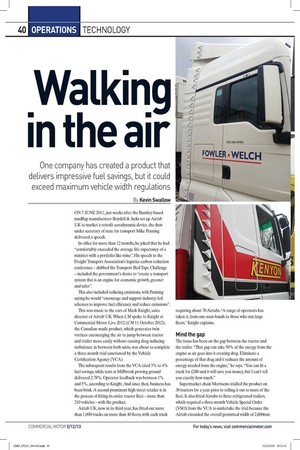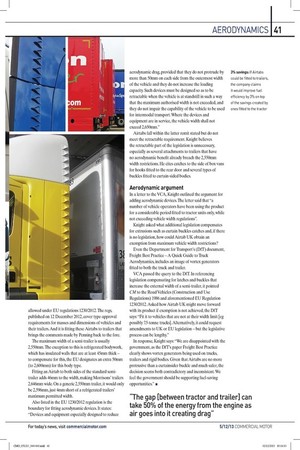Watkiqg in the air
Page 29

Page 30

If you've noticed an error in this article please click here to report it so we can fix it.
One company has created a product that delivers impressive fuel savings, but it could exceed maximum vehicle width regulations By Kevin Swallow
ON 7 JUNE 2011, just weeks after the Burnley-based mudflap manufacturer Boydell & Jacks set up Airtab UK to market a retrofit aerodynamic device, the then under secretary of state for transport Mike Penning delivered a speech.
In office for more than 12 months, he joked that he had "comfortably exceeded the average life expectancy of a minister with a portfolio like mine". His speech to the Freight Transport Association's logistics carbon reduction conference — dubbed the Transport Red Tape Challenge — included the government's desire to "create a transport system that is an engine for economic growth, greener and safer".
This also included reducing emissions, with Penning saying he would "encourage and support industry-led schemes to improve fuel efficiency and reduce emissions".
This was music to the ears of Mark Knight, sales director of Airtab UK. When CM spoke to Knight at Commercial Motor Live 2012 (CM 11 October 2012), the Canadian-made product, which generates twin vortices encouraging the air to jump between tractor and trailer more easily without causing drag-inducing turbulence in between both units, was about to complete a three-month trial sanctioned by the Vehicle Certification Agency (VCA).
The subsequent results from the VCA cited 3% to 4% fuel savings, while tests at Millbrook proving ground delivered 2.78%. Operator feedback was between 1% and 5%, according to Knight. And since then, business has been brisk. A second prominent high street retailer is in the process of fitting its entire tractor fleet — more than 210 vehicles — with the product. Airtab UK, now in its third year, has fitted-out more than 1,000 trucks on more than 40 fleets, with each truck
requiring about 70 Airtabs. "A range of operators has taken it, from one-man-bands to those who run large fleets," Knight explains. Mind the gap
The focus has been on the gap between the tractor and the trailer. "That gap can take 50% of the energy from the engine as air goes into it creating drag. Eliminate a percentage of that drag and it reduces the amount of energy needed from the engine," he says. "You can fit a truck for £280 and it will save you money, but I can't tell you exactly how much." Supermarket chain Morrisons trialled the product on 30 tractors for a year prior to rolling it out to more of the fleet. It also fitted Airtabs to three refrigerated trailers, which required a three-month Vehicle Special Order (VSO) from the VCA to undertake the trial because the Airtab extended the overall permitted width of 2,600mm
allowed under EU regulations 1230/2012. The regs, published on 12 December 2012, cover type-approval requirements for masses and dimensions of vehicles and their trailers. And it is fitting these Airtabs to trailers that brings the comments made by Penning back to the fore.
The maximum width of a semi-trailer is usually 2,550mm The exception to this is refrigerated bodywork, which has insulated walls that are at least 45mm thick — to compensate for this, the EU designates an extra 50mm (to 2,600mm) for this body type.
Fitting an Airtab to both sides of the standard semitrailer adds 46mm to the width, making Morrisons' trailers 2,646mm wide. On a generic 2,550mm trailer, it would only be 2,596mm, just 4mm short of a refrigerated trailers' maximum permitted width. Also listed in the EU 1230/2012 regulation is the boundary for fitting aerodynamic devices. It states: "Devices and equipment especially designed to reduce aerodynamic drag, provided that they do not protrude by more than 50mm on each side from the outermost width of the vehicle and they do not increase the loading capacity. Such devices must be designed so as to be retractable when the vehicle is at standstill in such a way that the maximum authorised width is not exceeded, and they do not impair the capability of the vehicle to be used for intermodal transport. Where the devices and equipment are in service, the vehicle width shall not exceed 2,650mm "
Airtabs fall within the latter remit stated but do not meet the retractable requirement. Knight believes the retractable part of the legislation is unnecessary, especially as several attachments to trailers that have no aerodynamic benefit already breach the 2,550mm width restrictions. He cites catches to the side of box vans for hooks fitted to the rear door and several types of buckles fitted to curtain-sided bodies. Aerodynamic argument
In a letter to the VCA, Knight outlined the argument for adding aerodynamic devices. The letter said that "a number of vehicle operators have been using the product for a considerable period fitted to tractor units only, while not exceeding vehicle width regulations".
Knight asked what additional legislation compensates for extrusions such as curtain buckles catches and, if there is no legislation, how could Airtab UK obtain an exemption from maximum vehicle width restrictions?
Even the Department for Transport's (DfT) document, Freight Best Practice — A Quick Guide to Truck Aerodynamics, includes an image of vortex generators fitted to both the truck and trailer.
VCA passed the query to the DfT. In referencing legislation compensating for latches and buckles that increase the external width of a semi-trailer, it pointed CM to the Road Vehicles (Construction and Use Regulations) 1986 and aforementioned EU Regulation 1230/2012. Asked how Airtab UK might move forward with its product if exemption is not achieved, the DfT says: "Fit it to vehicles that are not at their width limit [eg possibly 7.5-tonne trucks]. Alternatively, it could request amendments to UK or EU legislation — but the legislative process can be lengthy." In response, Knight says: "We are disappointed with the government, as the DfT's paper Freight Best Practice clearly shows vortex generators being used on trucks, trailers and rigid bodies. Given that Airtabs are no more protrusive than a curtainsider buckle and much safer, the decision seems both contradictory and inconsistent. We feel the government should be supporting fuel-saving opportunities." •




































